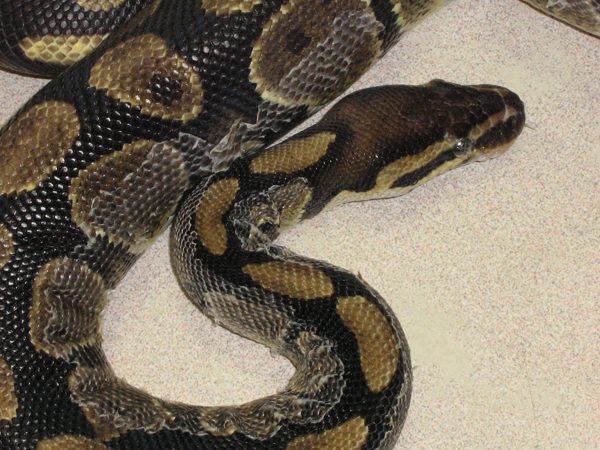Causes Dysecdysis means an abnormal shedding of the dead outer skin of a reptile. It often indicates suboptimal husbandry, however it may be a sign
Causes
Dysecdysis means an abnormal shedding of the dead outer skin of a reptile. It often indicates suboptimal husbandry, however it may be a sign of certain infectious diseases, such as external or internal parasites, septicemia, inclusion body disease of boids, ophidian paramyxovirus, internal abscesses, among others. Low levels of vitamin A in the diet may cause poor shedding, and occasionally dysecdsis may be from other non-infectious conditions.
KEVIN WRIGHT, DVM, DABVP (RA)
Monitor lizards can also suffer from Dysecdysis.
Species At-Risk
Snakes, lizards, worm lizards (amphisbaenids), and tuataras are the reptiles that tend to shed large portions of skin at one time and thereby more likely to suffer from dysecdysis. Aquatic turtles, such as red-eared sliders, may have trouble shedding the scutes of the shell but rarely show difficulty shedding the dead outer layers of their skin.
Symptoms/Signs
Dried shed stuck to the skin. Often this dried skin is obviously duller in color and less shiny than the surrounding skin but this may not be noticeable on reptiles with highly textured skin such as bearded dragons. It often constricts toes and the tips of tails and may accumulate over time into bands of old sheds that block the blood supply to the tail tip or toe tip and may cause the loss of this extremity. Leopard geckos often squint if they have trouble shedding the inside of each eyelid. This is common with chameleons too.
Predisposing Captive Conditions and/or Other Factors
Dysecdysis often indicates a problem with husbandry, such as low humidity, cool temperatures, or lack of appropriate substrate or cage furniture to rub against and initiate a shed. Many insectivorous reptiles have difficulty converting beta-carotene to vitamin A and are more likely to have problems shedding if their vitamin supplements lack pure vitamin A.
Aquatic turtles are more likely to have scute shedding problems if they can’t bask as long as they need to, if they have a diet deficient in vitamin A, or if the water is cooler than its should be.
KEVIN WRIGHT, DVM, DABVP (RA)
Sunburn in albino Burmese python due to UVB bulb.
Some reptiles may have dysecdysis secondary to “sunburn” from exposure to lights that emit too much ultraviolet light (e.g., UVA, UVB, or UVC). Many leucistic or amelanistic reptiles are very susceptible to sunburn.
Diagnostic Tests a Veterinarian May Recommend
Your veterinarian may ask detailed questions about your reptile’s husbandry. Make sure you bring in any vitamin supplements you use or write down their name and manufacturer so that your veterinarian may review their nutrients. If there are obvious problems with the husbandry and the reptile appears overall in good health, no tests may be needed.
A close examination for external parasites such as mites and ticks is appropriate. A fecal parasite examination is appropriate to rule out underlying infections. A CANV PCR test for yellow fungus (i.e., Chrysosporium anamorph of Nannizziopsis vriesii) may be appropriate if there are discolorations or thick areas to the unshed skin. Bloodwork may be needed if there overall health of the reptile is questionable. An ophidian paramyxovirus titer may be appropriate.
Safe Practices/Prevention
Isolate: There is no need to isolate a reptile with shedding difficulties unless a specific infectious disease is detected as a contributing factor.
Quarantine: There is no need to institute special quarantine for a reptile with shedding difficulties unless a specific infectious disease is detected as a contributing factor.
Proper hygiene and sanitation: Since an increase in humidity in all or a part of the cage is often required to resolve shedding problems, it is important to spot clean cage daily to remove droppings, uneaten food, shed skin, and other wastes and to deep clean and disinfect these items monthly. Throw out any organic materials such as wood if it appears moldy or otherwise visibly contaminated.
Treatments a Veterinarian Would Likely Recommend
Dysecdysis may be treated by placing the reptile in chin deep, cage temperature water for 30 minutes to loosen the retained shed before it is manually removed. A snake with extensive patches of retained skin may be placed inside a damp pillow case containing a moistened towel. This is then placed into its cage or other warm environment for several hours. As the snake crawls around, it removes the remaining pieces of retained shed, often including retained spectacles. If anything is left on the snake, it peels off easily by hand when the snake is removed from the bag.

KEVIN WRIGHT, DVM, DABVP (RA)
A snake with extensive patches of retained skin may be placed inside a damp pillow case containing a moistened towel.
Your veterinarian may advise increased humidity in all or part of the cage. This may be from adding a larger water bowl, increasing the length of misting and/or the frequency of misting, adding a humidifier, a change in the substrate, or the addition of a “humidity box.” This humidity box may be a plastic container half-filled with damp sphagnum moss or moist 0.5 to 1” cubes cut from foam rubber. A hole should be in one side large enough for the reptile to crawl through but not so large that the material inside dries out within a day.


